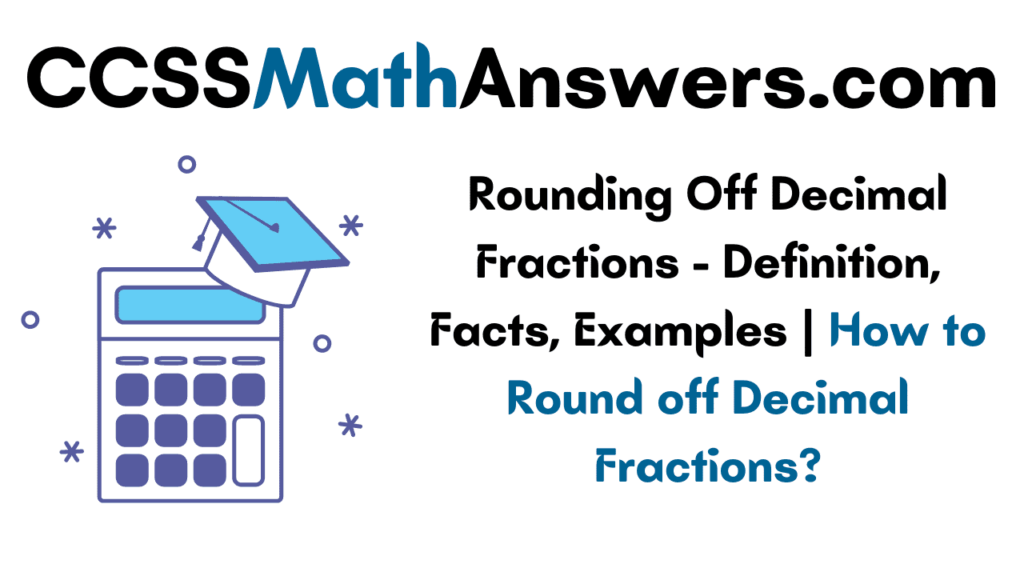Rounding Off Decimal Fractions is similar to Rounding off whole numbers. In order to round off the decimal fractions, you have to limit the number of decimal places that the number holds. Learn the simple tricks to round off decimal fractions from this page.
In this article, the students of 5th grade can improve their math skills and also create questions on rounding off decimal fractions on their own. We have provided step-by-step explanations for different types of questions related to rounding decimal fractions. Hence refer to our page to learn in-depth about rounding off decimal fractions.
Do Refer:
Decimal Fractions – Definition
A fraction where the denominator is a power of 10 such as 10,100,1000 is called a decimal fraction. We can write the decimal fractions with decimal points and no denominator.
How to Round Off Decimal Fractions?
1. If the number after the decimal point is greater than 5 then the answer will be greater than the given number.
2. If the number after the decimal point is less than 5 then the answer will be less than the given number.
Rounding Off Decimals to the Nearest One
In order to round the decimal fractions to the nearest one, we have to check the number after the decimal point. If the digit after the decimal point is greater than 5 then you have to round up the number. If the digit after the decimal point is less than 5 then you have to round down the number.
Example:
Round off the number 7.2 to the nearest one.
Solution:
Given the number 7.2
The digit after the decimal point is 2.
2 is less than 5, so you have to round down the number.
The number 7.2 to the nearest one is 7.
Rounding Off Decimals to the Nearest Tenths
In order to round the decimal fractions to the nearest tenths, we have to see the number after the decimal point. If the second digit after the decimal point is greater than 5 then you have to round up the number. If the second digit after the decimal point is less than 5 then you have to round down the number.
Example:
Round off the number 5.29 to the nearest tenths.
Solution:
Given the number 5.29
The second digit after the decimal point is 9.
9 is greater than 5, so you have to round up the number.
The number 5.29 to the nearest tenths is 5.3.
Rounding Off Decimals to the Nearest Hundredths
In order to round the decimal fractions to the nearest hundredths, we have to see the number after the decimal point. If the third digit after the decimal point is greater than 5 then you have to round up the number. If the third digit after the decimal point is less than 5 then you have to round down the number.
Example:
Round off the number 9.999 to the nearest hundredths.
Solution:
Given the number 9.999
The third digit after the decimal point is 9.
9 is greater than 5, so you have to round up the number.
The number 9.999 to the nearest hundredths is 10.
Rounding Off Decimal Fractions Examples
Example 1.
Round off 7.9 to the nearest one.
Solution:
Given the number 7.9
In order to round the decimal fractions to the nearest one, we have to check the number after the decimal point.
If the digit after the decimal point is greater than 5 then you have to round up the number.
If the digit after the decimal point is less than 5 then you have to round down the number.
Here the number in the one’s place is greater than 5 so we have to round up the number.
Therefore the decimal fraction 7.9 to the nearest one is 8.
Example 2.
Round off 6.1 to the nearest one.
Solution:
Given the number 6.1
In order to round the decimal fractions to the nearest one, we have to check the number after the decimal point.
If the digit after the decimal point is greater than 5 then you have to round up the number.
If the digit after the decimal point is less than 5 then you have to round down the number.
Here the number in the one’s place is less than 5 so we have to round down the number.
Therefore the decimal fraction 6.1 to the nearest one is 6.
Example 3.
Round off 5.63 to the nearest tenths.
Solution:
Given the decimal fraction of 5.63
If the second digit after the decimal point is greater than 5 then you have to round up the number.
If the second digit after the decimal point is less than 5 then you have to round down the number.
Here the number in the tenths place is less than 5 so we have to round down the number.
Therefore the decimal fraction 5.63 to the nearest tenths is 5.60
Example 4.
Round off 3.99 to the nearest tenths.
Solution:
Given the decimal fraction of 3.99
If the second digit after the decimal point is greater than 5 then you have to round up the number.
If the second digit after the decimal point is less than 5 then you have to round down the number.
Here the number in the tenths place is greater than 5 so we have to round up the number.
Therefore the decimal fraction 3.99 to the nearest tenths is 4
Example 5.
Round off 1.999 to the nearest hundredths.
Solution:
Given the decimal fraction of 1.999
If the third digit after the decimal point is greater than 5 then you have to round up the number.
If the third digit after the decimal point is less than 5 then you have to round down the number.
Here the number in the hundredths place is greater than 5 so we have to round up the number.
Therefore the decimal fraction 1.999 to the nearest tenths is 2
